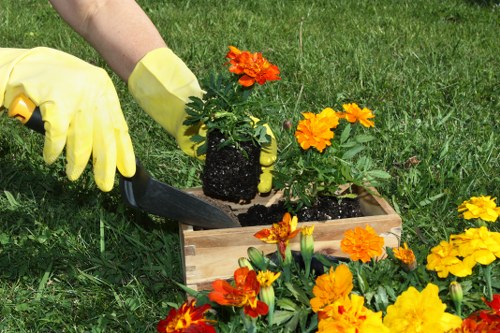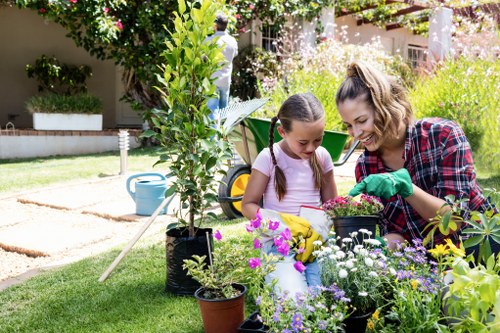Comprehensive Guide to Garden Maintenance
Introduction to Garden Maintenance

Maintaining a beautiful garden requires dedication, knowledge, and consistent effort. Whether you're a seasoned gardener or a beginner, understanding the fundamentals of garden maintenance is essential for ensuring your outdoor space remains vibrant and healthy throughout the year.
Garden maintenance encompasses a variety of tasks, from pruning and weeding to watering and fertilizing. Each of these activities plays a crucial role in the overall health and aesthetics of your garden.
In this article, we'll delve into the key aspects of garden maintenance, providing you with practical tips and strategies to keep your garden in top condition.
Essential Garden Maintenance Tasks

1. Pruning and Trimming
Regular pruning is vital for promoting healthy plant growth and maintaining the desired shape of your plants.
Prune dead or diseased branches to prevent the spread of pests and diseases. Additionally, trimming helps in directing the plant's energy towards producing flowers and new growth.
It's important to use the right tools and techniques to avoid damaging your plants during the pruning process.
Irrigation and Watering Strategies

2. Efficient Watering Practices
Proper watering is fundamental to garden maintenance. Overwatering can lead to root rot, while underwatering can cause plants to wilt and die.
Implementing an efficient watering schedule based on the specific needs of your plants ensures they receive the right amount of moisture.
Using drip irrigation systems can help conserve water and deliver it directly to the plant roots, reducing evaporation and runoff.
Soil Health and Fertilization

3. Soil Management
Healthy soil is the foundation of a thriving garden. Regularly testing your soil can help you understand its pH levels and nutrient content.
Amending the soil with compost or organic matter can enhance its structure, improve drainage, and provide essential nutrients to your plants.
Applying the appropriate fertilizers at the right times can further boost plant growth and productivity.
Pest and Weed Control

4. Maintaining a Pest-Free Garden
Garden pests can cause significant damage if not managed properly. Implementing integrated pest management (IPM) strategies can help control pest populations naturally.
Regularly inspecting your plants for signs of pests and diseases allows for early detection and timely intervention.
Using organic pesticides and encouraging beneficial insects can effectively reduce harmful pest infestations.
Seasonal Maintenance Tips
Each season brings its own set of maintenance challenges and opportunities. Adjusting your garden care practices according to the changing weather ensures year-round garden health.
For instance, in spring, focus on planting new seedlings and preparing the soil, while in autumn, concentrate on cleaning up fallen leaves and protecting plants from frost.
Understanding seasonal variations helps you anticipate and address potential issues before they escalate.
Tools and Equipment for Garden Maintenance
5. Investing in Quality Garden Tools
Having the right tools can make garden maintenance tasks more efficient and less labor-intensive.
Essential garden tools include pruning shears, a sturdy garden hose, a reliable watering can, and a set of hand tools for weeding and planting.
Regularly maintaining your tools by cleaning and sharpening ensures they remain effective and prolongs their lifespan.
Creating a Maintenance Schedule
Developing a structured maintenance schedule helps you stay organized and ensures that no essential tasks are overlooked.
Consider creating a monthly or weekly checklist tailored to your garden's specific needs and the types of plants you cultivate.
Sticking to a routine can significantly improve the overall health and appearance of your garden.
Sustainable Garden Practices
- Implementing composting to recycle garden waste.
- Using rain barrels to collect and store rainwater.
- Choosing native plants that require less water and are more resistant to local pests.
Adopting sustainable practices not only benefits your garden but also contributes to environmental conservation.
By reducing waste and conserving resources, you can create an eco-friendly garden that thrives naturally.
Emphasizing sustainability in garden maintenance promotes long-term garden health and resilience.
Common Garden Maintenance Mistakes to Avoid
- Overwatering or underwatering plants.
- Neglecting to remove dead or diseased plant material.
- Using the wrong fertilizers for your soil type.
Avoiding these common mistakes can prevent many issues that compromise garden health.
Educate yourself on the specific needs of your plants to tailor your maintenance efforts effectively.
Regular monitoring and adjustments to your maintenance routine can help mitigate potential problems.
Enhancing Garden Aesthetics
6. Designing for Visual Appeal
Beyond just maintenance, enhancing the visual appeal of your garden is important for creating a pleasant outdoor space.
Incorporate a variety of plant species, colors, and textures to add depth and interest to your garden design.
Using decorative elements like garden sculptures, pathways, and lighting can further elevate the aesthetics of your garden.
Conclusion and Next Steps
Effective garden maintenance is a blend of routine tasks, proper planning, and thoughtful design. By following the guidelines outlined in this article, you can ensure your garden remains a beautiful and healthy sanctuary.
Remember, consistency is key. Regular maintenance not only preserves the beauty of your garden but also enhances its resilience against pests, diseases, and environmental stressors.
Ready to take your garden to the next level? Contact us today to learn more about our professional garden maintenance services and how we can help you achieve your gardening goals.